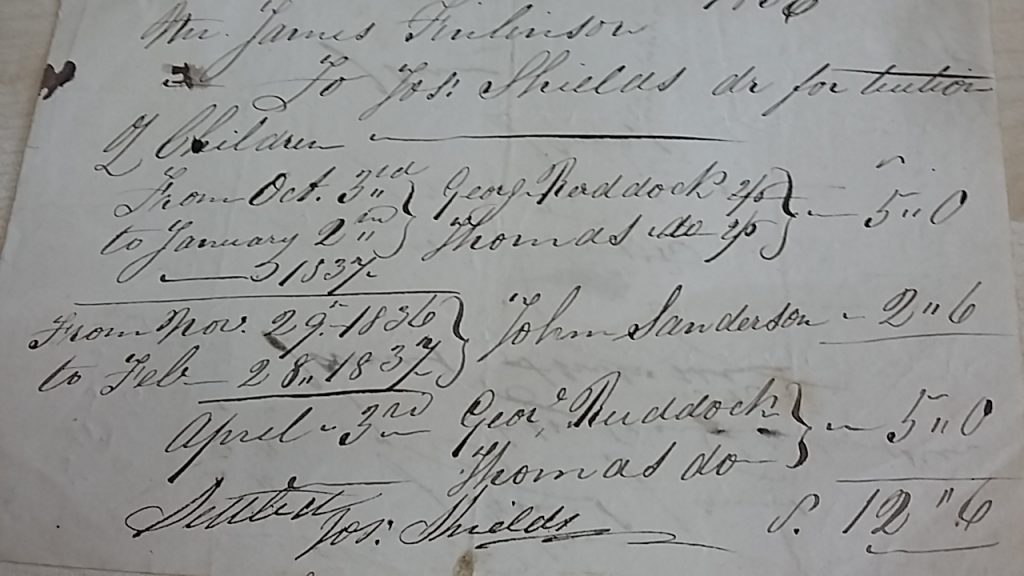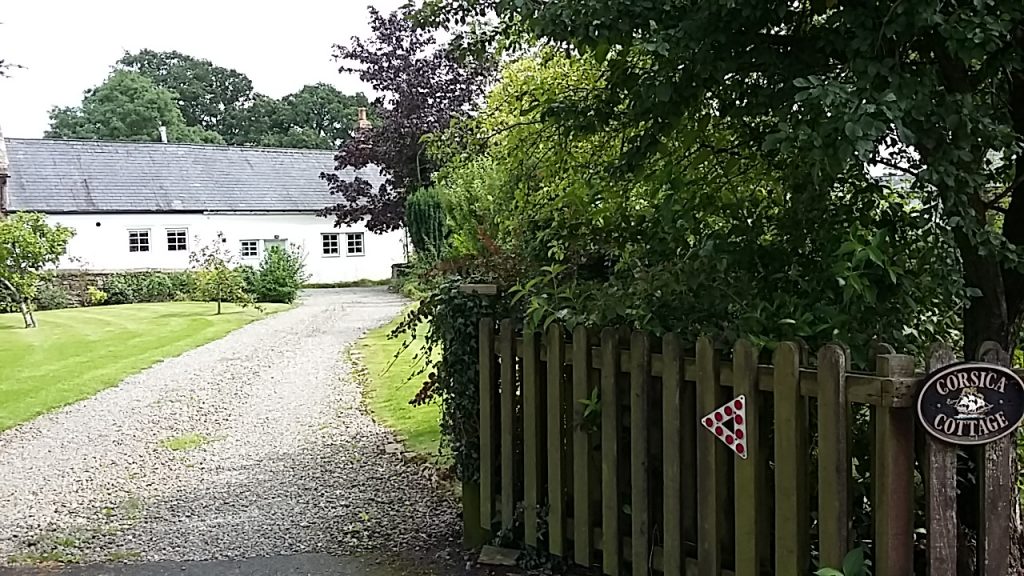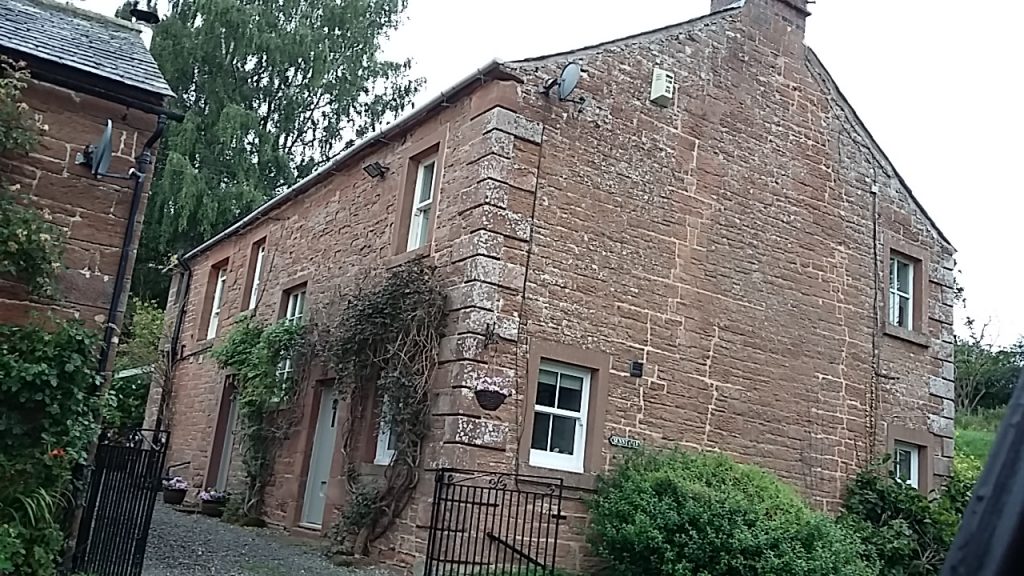
Schooling had been available in Dalston from the late 1600s. Jonathan Rowland, who died in Dalston on 28 August 1742, had been a schoolmaster for 50 years.[1]
With the development of local industry the population of Dalston grew along with the need for children to receive tuition. This could have provided Joseph Shields with the opportunity to increase his income by combining the roles of schoolmaster and grocer with yeoman. Alongside Dalston’s Grammar School (rebuilt in 1815) available to the poorer children of the parish, there were 16 further schools by 1831.[ 2]
Joseph Shields name appears on four overseers’ vouchers for Dalston Parish. [3] They are dated between 1835 and 1837 and concern the schooling of four boys: George and Thomas Roddick, John Sanderson and John Hind. A charge of 2s 6d was made for each boy for a fixed time span of one quarter per year. John Sanderson’s tuition lasted from 30 November 1835 to 1 March 1836.[4] Three girls from the local factory were also tutored for thirteen weeks each at 1d a day. The bill for them amounted to 3s 3d.[ 5] The 1d may have been deducted from their pay at the factory. The payments were made by James Finlinson, at one time Governor of the workhouse, and later Overseer and Surveyor of Dalston.[6]

Joseph Shields was born on 30 April 1795 in Kirkoswald, Cumberland. He was the son of Joshua Shields (1762-1841) and Margaret Boustead (1762- 1821).[7] Joseph moved to Wetheral and then to Dalston where he married Isabella Crozier, the daughter of Edward Crozier (1798- 1860) and Isabella Lambert (1795-1836) on Christmas Eve 1823. Both Joseph and Isabella signed the register suggesting they had had some education. When their son, Edward, was baptised on 11 June 1826, Joseph’s occupation was given as yeoman at Fountainhead, Near Dalston, but records for the subsequent baptisms of daughters Margaret (7 September 1827) Sarah (10 April 1830) and Isabella (14 August 1831) describe him as a schoolmaster.[8]
In 1834 Shields was listed as the teacher of boys and girls at Buckhowbank, Dalston. Others who also taught there were a Mr Monkhouse, Joseph Thomlinson, Thomas Stubbs, John Richardson’s wife, Esther MacLean (Cumdivock) John Davidson (Gaitskill),Widow Bailey (Raughton) Ann Blaylock (Stockdalewath), Mrs Twentyman and Miss Dugdale. [9 ]
The 1841 Census shows Shields’ occupation as a grocer. When his wife Isabella died (September 13 1845). [10] When the marriage details of his daughters Sarah and Isabella appear in the local papers, he is noted as a schoolmaster. [11] Mannix and Whellan’s directory (1847) lists him as a grocer and schoolmaster. [12] This switching between occupational titles was commonplace. Sometimes it reflected the social status connected with a particular trade or profession; at others it may have reflected the economic importance attached to their different occupations.
The overseers’ voucher does not make any reference to where the children were taught. Dalston Monumental Inscriptions notes refer to Joseph as ‘Keeping a hedge-school at Corsica’.[13] This refers to Corsica Cottage at Buckhowbank, Dalston. It could be that Joseph taught from a room in his own house. He later owned Sunny Vale near Stockdalewath.
The Carlisle Journal of 1853 [14] has a notice for a house , barn and outbuildings to be let at Sunny Vale. Stockdalewath. The same property was again advertised for rent in November 1857, with three acres of land attached being occupied by a Mr Waugh.[15] Further income for Joseph. This property was subsequently put up for sale after Joseph’s death (21 May 1858).[16]
Joseph’s will of 19 May 1858 gave instructions that his money (less than £20) and that from the sale of his property Sunny Vale should be divided between his 4 children: Edward who was living in Australia, having emigrated in 1857; and daughters Margaret (Brown) in Whitehaven, Isabella (Carlile) in Buckhowbank, and Sarah (Wannop), in Liverpool.[17]

Sources
[1] Cumbria Archives, DRC/2/95, Wilson, J., 1890, The Monumental Inscriptions of the Church, Churchyard and Cemetery of St Michael’s Dalston, Beck, W., (1890)
[2] Cumbria Archives, PR 41/52, Schools in the Parish of Dalston.
[3] Cumbria Archives, SPC44/2/52/1-4, Dalston Overseers’ Vouchers, 30 November 1835 to April 3 1837, Joseph Shields to James Finlinson for tuition of children.
[4]Cumbria Archives, SPC44/2/52/2, Dalston Overseers’ Vouchers, 30 November 1835 – 1 March 1836.
[5] Cumbria Archives, SPC44/2/52/1, Dalston Overseers’ Vouchers, May 31 to July 21 undated year
[6] Cumbria Archives, Vestry Notices Dalston Parish PR 41/152 List of schools and teachers, 1834.
.[7] Cumbria Archives, PR 9/2, Kirkoswald, St Oswald Parish, Baptism, Marriages and Burials 1659- 1809.
[8] Cumbria Archives, PR 41/8, Dalston Parish Register, 8 Baptisms 1813-1832; PR 41/10, Marriages, 1813-1837.
[9] Cumbria Archives, PR 41/152, Vestry Notices Dalston Parish List of schools and teachers, 1834.
[10] Carlisle Journal, 20 September 1845.
[11] Carlisle Patriot, 18 March 1854, (Isabella Shields); Carlisle Journal, 20 June 1856, (Sarah Shields).
[12] Mannx and Whellan, Directory of Cumberland, 1847.
[13] as [1] Notes et the end of the book with regard to headstones transcribed.
[14] Carlisle Journal, 8 January 1853.
[15] Carlisle Journal, 6 November 1857.
[16] Carlisle Journal, 13 July 1858
[17] Cumbria Archives, PROB 1858/W985b 19 May 1858.
Research is a work in progress and subject to change.
Any information about ‘Hedge Schools’ in England is welcome
